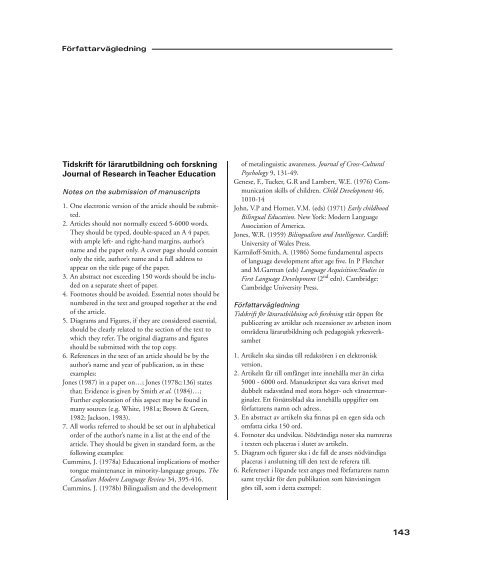idskrift - Umeå universitet
idskrift - Umeå universitet
idskrift - Umeå universitet
You also want an ePaper? Increase the reach of your titles
YUMPU automatically turns print PDFs into web optimized ePapers that Google loves.
Författarvägledning<br />
T<strong>idskrift</strong> för lärarutbildning och forskning<br />
Journal of Research in Teacher Education<br />
Notes on the submission of manuscripts<br />
1. One electronic version of the article should be submitted.<br />
2. Articles should not normally exceed 5-6000 words.<br />
They should be typed, double-spaced an A 4 paper,<br />
with ample left- and right-hand margins, author’s<br />
name and the paper only. A cover page should contain<br />
only the title, author’s name and a full address to<br />
appear on the title page of the paper.<br />
3. An abstract not exceeding 150 words should be included<br />
on a separate sheet of paper.<br />
4. Footnotes should be avoided. Essential notes should be<br />
numbered in the text and grouped together at the end<br />
of the article.<br />
5. Diagrams and Figures, if they are considered essential,<br />
should be clearly related to the section of the text to<br />
which they refer. The original diagrams and figures<br />
should be submitted with the top copy.<br />
6. References in the text of an article should be by the<br />
author’s name and year of publication, as in these<br />
examples:<br />
Jones (1987) in a paper on…; Jones (1978c:136) states<br />
that; Evidence is given by Smith et al. (1984)…;<br />
Further exploration of this aspect may be found in<br />
many sources (e.g. White, 1981a; Brown & Green,<br />
1982; Jackson, 1983).<br />
7. All works referred to should be set out in alphabetical<br />
order of the author’s name in a list at the end of the<br />
article. They should be given in standard form, as the<br />
following examples:<br />
Cummins, J. (1978a) Educational implications of mother<br />
tongue maintenance in minority-language groups. The<br />
Canadian Modern Language Review 34, 395-416.<br />
Cummins, J. (1978b) Bilingualism and the development<br />
of metalinguistic awareness. Journal of Cross-Cultural<br />
Psychology 9, 131-49.<br />
Genese, F., Tucker, G.R and Lambert, W.E. (1976) Communication<br />
skills of children. Child Development 46,<br />
1010-14<br />
John, V.P and Horner, V.M. (eds) (1971) Early childhood<br />
Bilingual Education. New York: Modern Language<br />
Association of America.<br />
Jones, W.R. (1959) Bilingualism and Intelligence. Cardiff:<br />
University of Wales Press.<br />
Karmiloff-Smith, A. (1986) Some fundamental aspects<br />
of language development after age five. In P Fletcher<br />
and M.Garman (eds) Language Acquisition:Studies in<br />
First Language Development (2 nd edn). Cambridge:<br />
Cambridge University Press.<br />
Författarvägledning<br />
T<strong>idskrift</strong> för lärarutbildning och forskning står öppen för<br />
publicering av artiklar och recensioner av arbeten inom<br />
områdena lärarutbildning och pedagogisk yrkesverksamhet<br />
1. Artikeln ska sändas till redaktören i en elektronisk<br />
version.<br />
2. Artikeln får till omfånget inte innehålla mer än cirka<br />
5000 - 6000 ord. Manuskriptet ska vara skrivet med<br />
dubbelt radavstånd med stora höger- och vänstermarginaler.<br />
Ett försättsblad ska innehålla uppgifter om<br />
författarens namn och adress.<br />
3. En abstract av artikeln ska finnas på en egen sida och<br />
omfatta cirka 150 ord.<br />
4. Fotnoter ska undvikas. Nödvändiga noter ska numreras<br />
i texten och placeras i slutet av artikeln.<br />
5. Diagram och figurer ska i de fall de anses nödvändiga<br />
placeras i anslutning till den text de referera till.<br />
6. Referenser i löpande text anges med författarens namn<br />
samt tryckår för den publikation som hänvisningen<br />
görs till, som i detta exempel:<br />
143

















